Jian Lu
Peking University
MyGO: Make your Goals Obvious, Avoiding Semantic Confusion in Prostate Cancer Lesion Region Segmentation
Jul 23, 2025Abstract:Early diagnosis and accurate identification of lesion location and progression in prostate cancer (PCa) are critical for assisting clinicians in formulating effective treatment strategies. However, due to the high semantic homogeneity between lesion and non-lesion areas, existing medical image segmentation methods often struggle to accurately comprehend lesion semantics, resulting in the problem of semantic confusion. To address this challenge, we propose a novel Pixel Anchor Module, which guides the model to discover a sparse set of feature anchors that serve to capture and interpret global contextual information. This mechanism enhances the model's nonlinear representation capacity and improves segmentation accuracy within lesion regions. Moreover, we design a self-attention-based Top_k selection strategy to further refine the identification of these feature anchors, and incorporate a focal loss function to mitigate class imbalance, thereby facilitating more precise semantic interpretation across diverse regions. Our method achieves state-of-the-art performance on the PI-CAI dataset, demonstrating 69.73% IoU and 74.32% Dice scores, and significantly improving prostate cancer lesion detection.
Dyna3DGR: 4D Cardiac Motion Tracking with Dynamic 3D Gaussian Representation
Jul 22, 2025Abstract:Accurate analysis of cardiac motion is crucial for evaluating cardiac function. While dynamic cardiac magnetic resonance imaging (CMR) can capture detailed tissue motion throughout the cardiac cycle, the fine-grained 4D cardiac motion tracking remains challenging due to the homogeneous nature of myocardial tissue and the lack of distinctive features. Existing approaches can be broadly categorized into image based and representation-based, each with its limitations. Image-based methods, including both raditional and deep learning-based registration approaches, either struggle with topological consistency or rely heavily on extensive training data. Representation-based methods, while promising, often suffer from loss of image-level details. To address these limitations, we propose Dynamic 3D Gaussian Representation (Dyna3DGR), a novel framework that combines explicit 3D Gaussian representation with implicit neural motion field modeling. Our method simultaneously optimizes cardiac structure and motion in a self-supervised manner, eliminating the need for extensive training data or point-to-point correspondences. Through differentiable volumetric rendering, Dyna3DGR efficiently bridges continuous motion representation with image-space alignment while preserving both topological and temporal consistency. Comprehensive evaluations on the ACDC dataset demonstrate that our approach surpasses state-of-the-art deep learning-based diffeomorphic registration methods in tracking accuracy. The code will be available in https://github.com/windrise/Dyna3DGR.
CustomTTT: Motion and Appearance Customized Video Generation via Test-Time Training
Dec 23, 2024Abstract:Benefiting from large-scale pre-training of text-video pairs, current text-to-video (T2V) diffusion models can generate high-quality videos from the text description. Besides, given some reference images or videos, the parameter-efficient fine-tuning method, i.e. LoRA, can generate high-quality customized concepts, e.g., the specific subject or the motions from a reference video. However, combining the trained multiple concepts from different references into a single network shows obvious artifacts. To this end, we propose CustomTTT, where we can joint custom the appearance and the motion of the given video easily. In detail, we first analyze the prompt influence in the current video diffusion model and find the LoRAs are only needed for the specific layers for appearance and motion customization. Besides, since each LoRA is trained individually, we propose a novel test-time training technique to update parameters after combination utilizing the trained customized models. We conduct detailed experiments to verify the effectiveness of the proposed methods. Our method outperforms several state-of-the-art works in both qualitative and quantitative evaluations.
Neuro-symbolic Learning Yielding Logical Constraints
Oct 28, 2024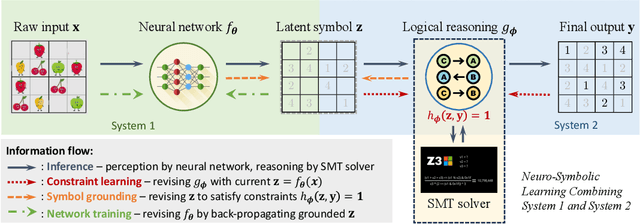
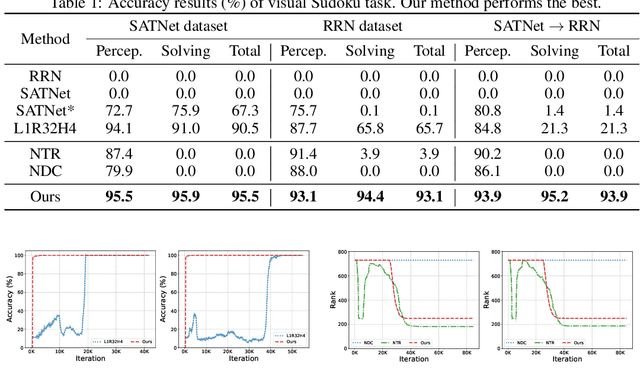

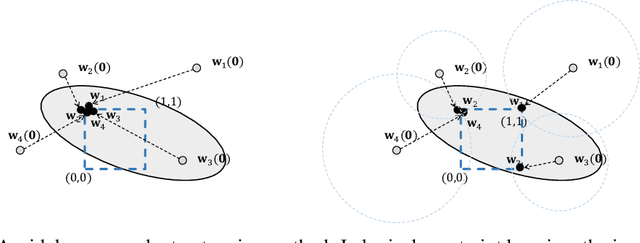
Abstract:Neuro-symbolic systems combine the abilities of neural perception and logical reasoning. However, end-to-end learning of neuro-symbolic systems is still an unsolved challenge. This paper proposes a natural framework that fuses neural network training, symbol grounding, and logical constraint synthesis into a coherent and efficient end-to-end learning process. The capability of this framework comes from the improved interactions between the neural and the symbolic parts of the system in both the training and inference stages. Technically, to bridge the gap between the continuous neural network and the discrete logical constraint, we introduce a difference-of-convex programming technique to relax the logical constraints while maintaining their precision. We also employ cardinality constraints as the language for logical constraint learning and incorporate a trust region method to avoid the degeneracy of logical constraint in learning. Both theoretical analyses and empirical evaluations substantiate the effectiveness of the proposed framework.
Revisiting Multi-Modal LLM Evaluation
Aug 09, 2024
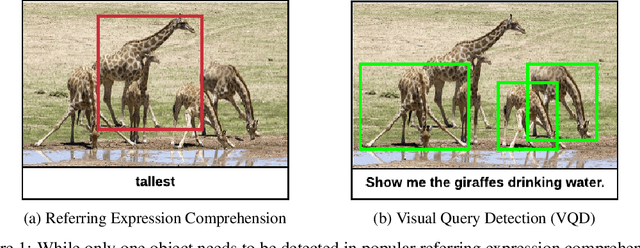

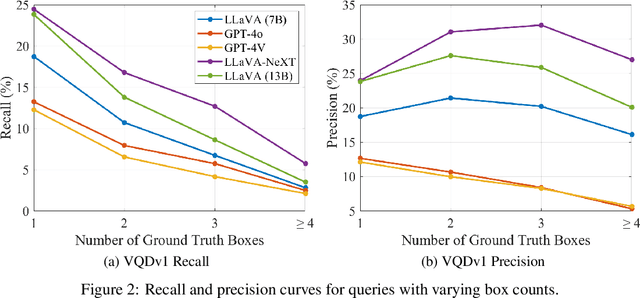
Abstract:With the advent of multi-modal large language models (MLLMs), datasets used for visual question answering (VQA) and referring expression comprehension have seen a resurgence. However, the most popular datasets used to evaluate MLLMs are some of the earliest ones created, and they have many known problems, including extreme bias, spurious correlations, and an inability to permit fine-grained analysis. In this paper, we pioneer evaluating recent MLLMs (LLaVA 1.5, LLaVA-NeXT, BLIP2, InstructBLIP, GPT-4V, and GPT-4o) on datasets designed to address weaknesses in earlier ones. We assess three VQA datasets: 1) TDIUC, which permits fine-grained analysis on 12 question types; 2) TallyQA, which has simple and complex counting questions; and 3) DVQA, which requires optical character recognition for chart understanding. We also study VQDv1, a dataset that requires identifying all image regions that satisfy a given query. Our experiments reveal the weaknesses of many MLLMs that have not previously been reported. Our code is integrated into the widely used LAVIS framework for MLLM evaluation, enabling the rapid assessment of future MLLMs. Project webpage: https://kevinlujian.github.io/MLLM_Evaluations/
EMBANet: A Flexible Efffcient Multi-branch Attention Network
Jul 07, 2024Abstract:This work presents a novel module, namely multi-branch concat (MBC), to process the input tensor and obtain the multi-scale feature map. The proposed MBC module brings new degrees of freedom (DoF) for the design of attention networks by allowing the type of transformation operators and the number of branches to be flexibly adjusted. Two important transformation operators, multiplex and split, are considered in this work, both of which can represent multi-scale features at a more granular level and increase the range of receptive fields. By integrating the MBC and attention module, a multi-branch attention (MBA) module is consequently developed to capture the channel-wise interaction of feature maps for establishing the long-range channel dependency. By substituting the 3x3 convolutions in the bottleneck blocks of the ResNet with the proposed MBA, a novel block namely efficient multi-branch attention (EMBA) is obtained, which can be easily plugged into the state-of-the-art backbone CNN models. Furthermore, a new backbone network called EMBANet is established by stacking the EMBA blocks. The proposed EMBANet is extensively evaluated on representative computer vision tasks including: classification, detection, and segmentation. And it demonstrates consistently superior performance over the popular backbones.
Orthogonal Constrained Minimization with Tensor $\ell_{2,p}$ Regularization for HSI Denoising and Destriping
Jul 04, 2024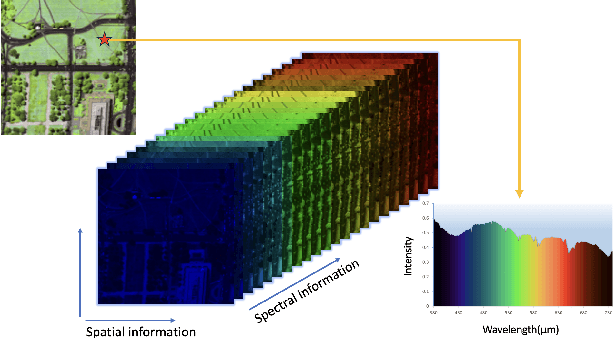
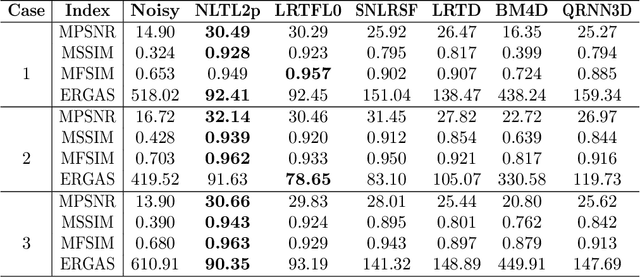

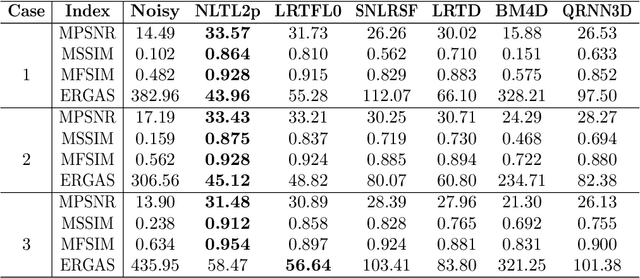
Abstract:Hyperspectral images (HSIs) are often contaminated by a mixture of noises such as Gaussian noise, dead lines, stripes, and so on. In this paper, we propose a novel approach for HSI denoising and destriping, called NLTL2p, which consists of an orthogonal constrained minimization model and an iterative algorithm with convergence guarantees. The model of the proposed NLTL2p approach is built based on a new sparsity-enhanced Nonlocal Low-rank Tensor regularization and a tensor $\ell_{2,p}$ norm with $p\in(0,1)$. The low-rank constraints for HSI denoising utilize the spatial nonlocal self-similarity and spectral correlation of HSIs and are formulated based on independent higher-order singular value decomposition with sparsity enhancement on its core tensor to prompt more low-rankness. The tensor $\ell_{2,p}$ norm for HSI destriping is extended from the matrix $\ell_{2,p}$ norm. A proximal block coordinate descent algorithm is proposed in the NLTL2p approach to solve the resulting nonconvex nonsmooth minimization with orthogonal constraints. We show any accumulation point of the sequence generated by the proposed algorithm converges to a first-order stationary point, which is defined using three equalities of substationarity, symmetry, and feasibility for orthogonal constraints. In the numerical experiments, we compare the proposed method with state-of-the-art methods including a deep learning based method, and test the methods on both simulated and real HSI datasets. Our proposed NLTL2p method demonstrates outperformance in terms of metrics such as mean peak signal-to-noise ratio as well as visual quality.
Capabilities of Gemini Models in Medicine
May 01, 2024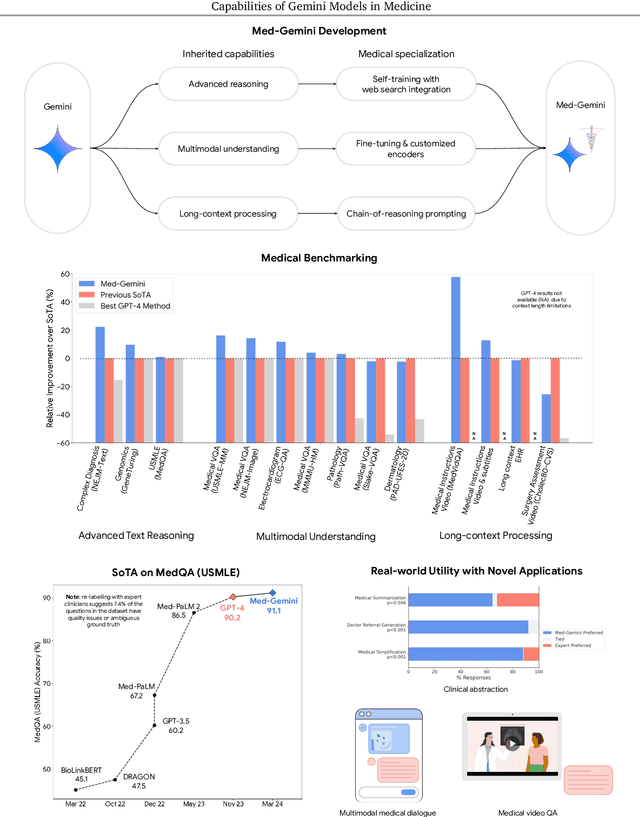

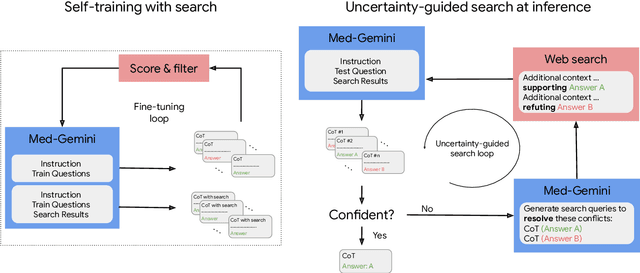

Abstract:Excellence in a wide variety of medical applications poses considerable challenges for AI, requiring advanced reasoning, access to up-to-date medical knowledge and understanding of complex multimodal data. Gemini models, with strong general capabilities in multimodal and long-context reasoning, offer exciting possibilities in medicine. Building on these core strengths of Gemini, we introduce Med-Gemini, a family of highly capable multimodal models that are specialized in medicine with the ability to seamlessly use web search, and that can be efficiently tailored to novel modalities using custom encoders. We evaluate Med-Gemini on 14 medical benchmarks, establishing new state-of-the-art (SoTA) performance on 10 of them, and surpass the GPT-4 model family on every benchmark where a direct comparison is viable, often by a wide margin. On the popular MedQA (USMLE) benchmark, our best-performing Med-Gemini model achieves SoTA performance of 91.1% accuracy, using a novel uncertainty-guided search strategy. On 7 multimodal benchmarks including NEJM Image Challenges and MMMU (health & medicine), Med-Gemini improves over GPT-4V by an average relative margin of 44.5%. We demonstrate the effectiveness of Med-Gemini's long-context capabilities through SoTA performance on a needle-in-a-haystack retrieval task from long de-identified health records and medical video question answering, surpassing prior bespoke methods using only in-context learning. Finally, Med-Gemini's performance suggests real-world utility by surpassing human experts on tasks such as medical text summarization, alongside demonstrations of promising potential for multimodal medical dialogue, medical research and education. Taken together, our results offer compelling evidence for Med-Gemini's potential, although further rigorous evaluation will be crucial before real-world deployment in this safety-critical domain.
LE-SSL-MOS: Self-Supervised Learning MOS Prediction with Listener Enhancement
Nov 17, 2023



Abstract:Recently, researchers have shown an increasing interest in automatically predicting the subjective evaluation for speech synthesis systems. This prediction is a challenging task, especially on the out-of-domain test set. In this paper, we proposed a novel fusion model for MOS prediction that combines supervised and unsupervised approaches. In the supervised aspect, we developed an SSL-based predictor called LE-SSL-MOS. The LE-SSL-MOS utilizes pre-trained self-supervised learning models and further improves prediction accuracy by utilizing the opinion scores of each utterance in the listener enhancement branch. In the unsupervised aspect, two steps are contained: we fine-tuned the unit language model (ULM) using highly intelligible domain data to improve the correlation of an unsupervised metric - SpeechLMScore. Another is that we utilized ASR confidence as a new metric with the help of ensemble learning. To our knowledge, this is the first architecture that fuses supervised and unsupervised methods for MOS prediction. With these approaches, our experimental results on the VoiceMOS Challenge 2023 show that LE-SSL-MOS performs better than the baseline. Our fusion system achieved an absolute improvement of 13% over LE-SSL-MOS on the noisy and enhanced speech track. Our system ranked 1st and 2nd, respectively, in the French speech synthesis track and the challenge's noisy and enhanced speech track.
OSRE: Object-to-Spot Rotation Estimation for Bike Parking Assessment
Mar 01, 2023

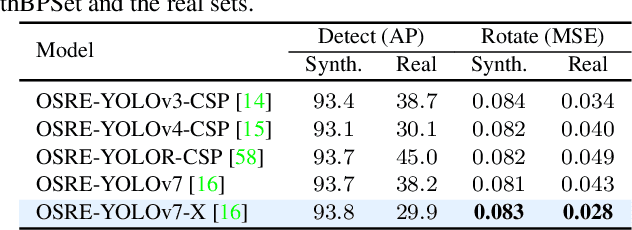
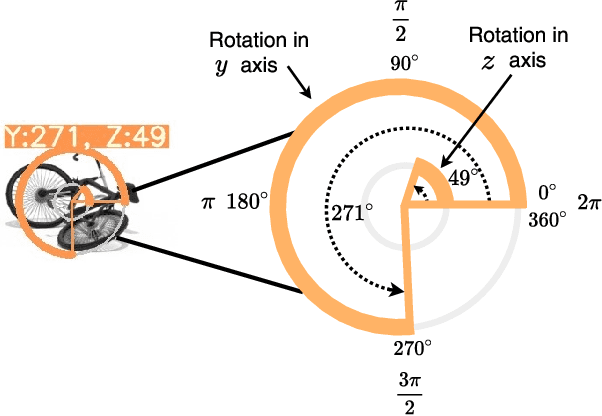
Abstract:Current deep models provide remarkable object detection in terms of object classification and localization. However, estimating object rotation with respect to other visual objects in the visual context of an input image still lacks deep studies due to the unavailability of object datasets with rotation annotations. This paper tackles these two challenges to solve the rotation estimation of a parked bike with respect to its parking area. First, we leverage the power of 3D graphics to build a camera-agnostic well-annotated Synthetic Bike Rotation Dataset (SynthBRSet). Then, we propose an object-to-spot rotation estimator (OSRE) by extending the object detection task to further regress the bike rotations in two axes. Since our model is purely trained on synthetic data, we adopt image smoothing techniques when deploying it on real-world images. The proposed OSRE is evaluated on synthetic and real-world data providing promising results. Our data and code are available at \href{https://github.com/saghiralfasly/OSRE-Project}{https://github.com/saghiralfasly/OSRE-Project}.
 Add to Chrome
Add to Chrome Add to Firefox
Add to Firefox Add to Edge
Add to Edge